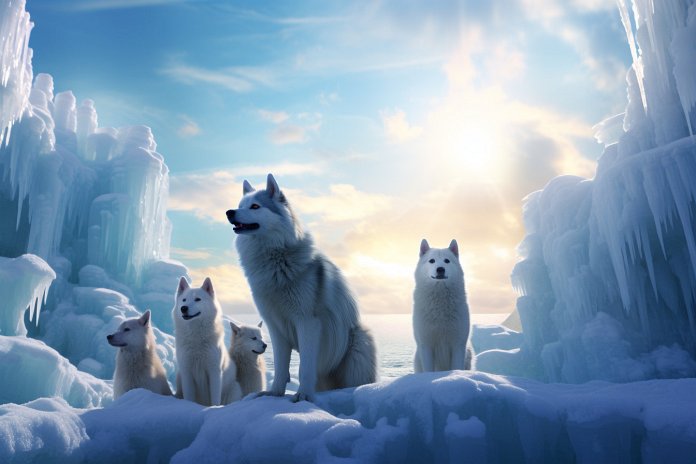
Sometimes the simplest questions are the most difficult to answer. We know dogs have an amazing sense of smell and can detect odor molecules from a long distance away. So, can dogs smell ice?
Water doesn’t tend to have much of a smell, so it’s reasonable to assume that ice doesn’t either. But could dogs detect the “cold” part of the ice and sense a temperature gradient? Or is it possible that ice does have a subtle smell that humans can’t detect? Let’s find out.
Signs a Dog is Following a Scent
Certain dog breeds were specifically created for sniffing out scents or tracking. These dogs have a super-sensitive nose finely tuned to pick up smells. When tracking, a trained dog moves in a focused way and exhibits distinct body language depending on how close they are to the scent.
When the scent is far away, the dog moves quickly in a zig-zag pattern and takes shallow sniffs. This helps them determine the direction of the strongest scent. As the scent gets stronger, the dog slows down and takes fewer but deeper breaths to analyze the air. They can gather information about the freshness of the scent and who left it. When the dog is very close, they may offer a physical reaction to indicate the location to their handler.
Body Language
The body language of a dog following a scent includes staring, head tilting, whining, howling, pacing, and sniffing. Other signs include walking in a zig-zagging path, an alert tail up, nose to the ground, and rapid shallow sniffing followed by fewer, deeper breaths.
The History of Dogs Using Their Sense of Smell
Dogs have been used for their sense of smell for various purposes throughout history. Detection dogs are now commonly used for security, not just for sniffing explosives but also for detecting currency, smuggled food, and even medical conditions like low blood sugar or cancer. This natural talent is one reason dogs were domesticated and became companions to humans.
The formal training of sniffer dogs began during World War II when dogs were trained to sniff out unexploded landmines. This opened up possibilities for other uses of a dog’s nose.
The Science of Dogs Smelling Ice
Does ice actually have a smell? Some argue that ice cubes from the freezer have a faint but distinctive odor, and indoor ice-rinks have an elusive scent. Ice is made from water, which may contain minerals with barely detectable scents, but when trapped in ice, these minerals may rise to the surface and be given off as an odor. Ice blocks in the freezer may also absorb the odor of other items, giving them a slight smell.
However, ice melts, making it difficult for a sniffer dog to detect. Training dogs to detect more stable substances is easier.
Training a Dog to Detect a Specific Substance
Teaching a dog to sniff out a specific substance can be done by using a game like “tug.” Start with a clean towel as the tug toy and play with the dog. Then introduce a second towel with the odor of the target object. Encourage the dog to choose the odor-marked towel for a game of tug and reward them when they do. Increase the difficulty by placing the odor-impregnated towel farther away or hiding it in a room with other towels. When the dog chooses the correct towel, praise them and play tug. Finally, put this behavior on cue using words like “Find” or “Detect.”
In conclusion
, while dogs can probably smell ice, training them to do so is challenging due to ice melting. However, teaching them to detect other substances is more feasible.“In the fascinating world of scent detection, can dogs sniff out something as seemingly odorless as ice?”

Tips & Things to Know
1️⃣ Dogs have a highly developed sense of smell and can detect scents that humans cannot. They can even pick up on subtle smells like those from ice, which may have a faint odor due to trapped minerals.
2️⃣ When a dog is following a scent, they exhibit certain body language cues such as staring, sniffing, pacing, and walking in a zig-zag pattern. As they get closer to the scent, they may exhibit a distinctive physical reaction like lifting a paw to point.
3️⃣ Teaching a dog to detect a specific substance, like the odor of an object, can be done through positive reinforcement training. By associating the scent with a fun game like tug, the dog learns to recognize and search for that particular smell.
Frequently Asked Questions, Answered ✅
1. Can dogs smell ice?
– Yes, it is possible that dogs can smell ice due to the faint odor it may have from minerals trapped in the ice or from absorbing odors from the freezer.
2. How do dogs follow a scent trail?
– Dogs use a combination of movement and rapid sniffing to determine the direction of the scent. As they get closer, they take fewer but deeper breaths to gather more information about the scent.
3. What are the signs that a dog is following a scent?
– Signs include walking in a zig-zag pattern, having the tail up and alert, keeping the nose to the ground, and using rapid shallow sniffing followed by fewer, deeper breaths.
4. What is the history of dogs using their sense of smell?
– Dogs have been used for their sense of smell for various purposes throughout history, including hunting prey, providing companionship, guarding, and detecting substances like explosives or cancer.
5. How can dogs be trained to detect a specific substance?
– Dogs can be trained to detect a specific substance by associating the scent with a fun and rewarding game, gradually increasing the difficulty by introducing odor-impregnated towels and hiding them, and eventually putting the behavior on cue with specific words like “Find” or “Detect”.